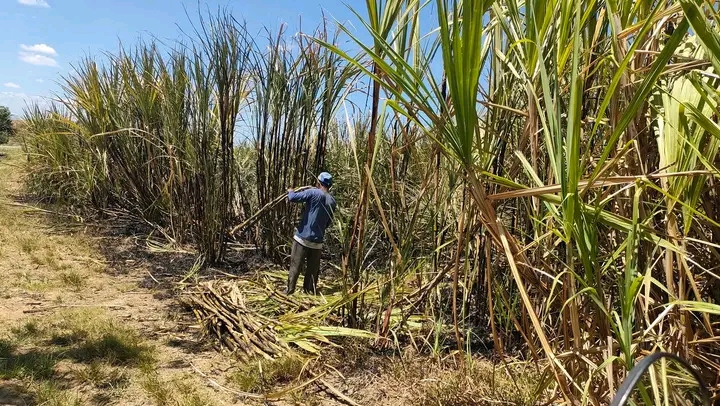Nairobi,
Tuesday, 30 April, 2024
McCreadie Andias
Agriculture carries the biggest portion in Kenya’s economic pie chart making it the largest contributor to Kenya’s gross domestic product (GDP) despite the fact that only 15-17% of the land has sufficient fertility and rainfall to be farmed and only 7-8% can be considered to be first-class land.
Kenya is one of the biggest producers of sugarcane both regionally and globally while maize farming remains an integral contributor to Kenya’s Agricultural sector, the product being consumed locally as staple food.
Despite this, Local farmers especially from within the Western and Nyanza region have gradually shifted interest from Maize to sugar farming largely contributed by fluctuating market disparities between the two crops.
Looking at how sugarcane has displaced maize farming, various factors have to be critically considered, the question of Government policies, profits, marketability and cost of production bearing the biggest weight.
First of all, Where does the government lie in this comparison? With no doubt the government has been making giant steps to revamp the sugar sector first by leveraging the purchasing power of farmers and reviving giant millers that had previously been laid at the bed of oblivion due to liquidity and debts.
President William Ruto has proved his commitment and support to the sugar sector and alluded to writing off Sh117bilion debt owned by state-owned sugarcane factories in the country and some loans advanced to the sugar millers. An act of good faith by the president which offers a sigh of relief to farmer who will no longer have to worry about their source of livelihoods collapsing. A promising future to sugar farmers from the head of state.
The government has also shown rising support in the sugar sector by holding various sugar conferences in western Kenya while creating production subsidies to cushion sugar farmers. This has created promising pathway for a better future for sugar farmers who have earned confidence that with the government’s support, the industry can not fail.
On September, 8 2023, Governors from 14 counties in the Lake Region Economic Bloc (LREB) including Kakamega, Nandi, Homa Bay, Bungoma, Busia, Bomet, Vihiga, Trans Nzoia, Kisumu, Migori, Kisii, Narok, Siaya and Kericho converged at the Masinde Muliro University of science and technology for the inaugural Sugar conference to push for sugar reforms among them, reintroduction of the Kenya Sugar Board and revitalisation of farming in the region.
One of the main resolutions of the conference targeted devolution, where County Governments should be involved in the management and development of the sugar sector. After writing off the liabilities, counties should assume 20% of government shareholding with 80% going to farmers through out grower organizations. Such recommendations are a huge sigh of hope for better in the sugar industry wooing other farmers to give a shot in the sugar sector owing to the promising resolutions.
Evidently the maize sector has been struggling to maintain it’s dominance and rather left underlooked or deserted. Back in 2017,then Lugari MP Ayub Savula was on record grieving on the Government’s ‘little support ‘for maize farmers in western Kenya. The legislator said most farmers are abandoning the crop for sugarcane due to lack of support from the government.
He said this has negatively affected the region’s food security. Savula went on to suggest that Maize farmers in Western should be given incentives and subsidies to increase production and address food insecurity, something that could have only ended in deaf ears to date.
“We need the law so areas suitable for growing maize are protected. The government must ensure both sugar cane and maize growers are given incentives to encourage them to produce more,.” Savula said.
Same year 2017, Then Agriculture CS Willy Bett said a law must be enacted to zone areas of Western for maize production to help avert a food crisis in the country.
Bett raised the red flag following the rate at which sugar cane is displacing maize farming, particularly in Lugari and Likuyani in Kakamega and Kitale in Trans Nzoia counties where maize farming had been initially predominant.
The cost of production is a very important factor that has also led to this unprecedented shift.
Still Savula brought the same up noting that farmers in Kakamega, Bungoma and Trans Nzoia counties have opted for cane because of the high cost of maize production.
Trans Nzoia alone accounts for at least 80 percent of maize production in Kenya.But farmers have slowly started to embrace sugar cane farming due to high costs of maize production and frequent invasion by the fall armyworms.
On fertilizer consumption, Maize consumes more nitrogenous fertilizer than Sugarcane, The amount of fertilizer required is best calculated by multiplying the target yield in tons per hectare, by 20-25 Kg. In which for a 30 bag of maize per acre crop this is 160 Kg of nitrogen while despite the fact that sugarcane is also a heavy nitrogen user Nitrogen should be applied at 60 to 100 pounds per acre (27 to 45 kilos/. 40 ha). The lower amount is for lighter soil while the higher amount is in heavy soils.In this comparison Maize will require about 115 Kilos of DAP more than sugarcane which makes its production expensive.
Similarly, Maize farming would have a relatively higher Labour intensive from cultivating the land at least twice, planting the seeds, regular spraying of pesticides and herbicides then Harvesting.
Looking at the same weight of production, you can struggle to convince a farmer at a small village in Shianda, Mumias county that it would cost him more to farm sugar than maize, why? For farmers in sugar villages, it has been convenient to grow sugarcane because the factory has been providing seeds, harvesting with transport and even incentives.This has cushioned them from spending more on buying seeds, hiring labor for harvest and transportation costs of the cane to Millers as compared to Maize farmer who will carry the full cost.
Lack of hybrid maize seeds that are resistant to pests and diseases has often grappled farmers with heavy losses due to pest attacks hence opting for sugarcane.
Farmers in the region have relentlessly pushed for the release of new maize varieties that are high-yielding and tolerant to diseases, pests and even drought.
Furthermore, sugarcane farming offers environmental benefits over maize farming. Sugarcane is a perennial crop that requires less frequent replanting compared to maize which is an annual crop, sugarcane grows back after each harvest. After five or six “regrowths”, the old plants are pulled up and “virgin cane” is planted. Sugarcane is propagated by taking cuttings from the stem and burying them horizontally.
Additionally, By growing on its own, sugarcane reduces soil erosion and conserves soil fertility, contributing to sustainable land management practices. Sugarcane cultivation can also act as a carbon sink, sequestering carbon dioxide from the atmosphere and mitigating climate change impacts which pushed for a recommendation at the sugar conference for sugar farmers to receive credit funds to acknowledge the contribution of their farming to combating climate change. Meanwhile, maize farming often involves intensive use of agrochemicals such as fertilizers and pesticides, which can lead to soil degradation, water pollution, and biodiversity loss.
On the economic aspect. Sugarcane has recently been more lucrative. farming sugarcane often yields higher returns compared to maize farming due to the higher market value of sugarcane and its by-products such as sugar, molasses and ethanol. Kenya has a well-established sugar industry, with both domestic consumption and export markets. The demand for sugar remains relatively high, providing stable revenue streams for sugarcane farmers. The government has revitalized millers Like Mumias, Nzoia, Sony, Muhoroni, Kabras and Butali which in return have promoted the purchasing power of farmers . Additionally, sugarcane by-products like bagasse can be used to generate electricity, further adding to the economic viability of sugarcane farming.millers are also able to sell the by-products of sugar to Molasses companies like Kisumu molasses which uses the by products to produce Agrovets.
On the other hand, maize farming faces challenges such as price fluctuations and market saturation. Maize prices can be volatile, influenced by factors like weather conditions, government policies, and global market trends. Farmers often struggle with low prices during bumper harvest seasons, leading to financial instability. Moreover, the maize market in Kenya is highly competitive, with many small-scale farmers vying for limited market share, which can drive down prices and reduce profitability.
Recently it was a Big win for sugarcane farmers as giant millers including Butali, Mumias and West sugar raised their delivery prices.For the first time in many months, Western Kenya Sugar, Mumias and Butali hiked prices at which they buy sugarcane to upto Ksh 6,600 per tonne from ksh 5,250 and Ksh 4,584 initially back.
Meanwhile, Maize prices per sack have witnessed frequent depreciation going down to Ksh. 2500/= per sack despite the high cost of production.
Mathematically, under the best farm practices, one acre of land for a sugarcane farmer will produce about 120 tonnes of cane which would earn him Ksh.780,000 if the Miller purchases a tone as per the Ksh 6,600 current market value while an acre of maize farm under the best farming practices would produce not more than 40 bags of maize earning the farmer Ksh 100,000 if the National Cereals and produce board(NCPB) will purchase a bag by Ksh 2500 as per the current market value. The profit difference here is absolutely crazy. Yes the sugarcane farmer will take one harvest season on a 16-month maturity period while the maize farmer will harvest twice per farming calendar but will still not match the profits of the sugar farmer.
Of Course the cane farmer will part ways with Ksh.600 per tonne which is conditionally deducted from their payment to cover the transportation costs of the cane to the factory provided by the Miller but let’s not forget the maize farmer will still have spend more on pesticides and fertilizers during production as compared to sugarcane.
At the same time, When there is a dependable marketplace for sugarcane in the face of giant millers like Mumias, West Kenya or Muhoroni Sugar Factory, there is none for maize especially in Western and Nyanza regions. For instance, Small-scale maize farmers in Shianda have two options when selling their maize, whether to sell it during the harvesting season, when the price is often below the net value or store their maize to even out fluctuations in market supply by taking produce off the market in surplus season and releasing it back onto the market in lean season, receiving higher price but suffer heavy losses, both of which are detrimental to the farmers.
We have seen the National Cereals and produce board threaten maize farmers to sell their maize at a cheaper price or risk having their product rot in stalls, the same NCPB has been hit by major scandals of either not paying farmers on time or importing maize though cartels which has negatively affected local farmers, with NCPB being their primary market they are unable to either buy trust or fair bargaining power from them.
Savula was on record noting that lack of a ready market and elaborate value addition chains to help maize farmers recoup their investments is also a factor.
From a socio-economic perspective, sugarcane farming has the potential to create more employment opportunities and stimulate rural development compared to maize farming. The sugar industry in Kenya supports a network of smallholder farmers, laborers, and agro-industries, contributing to local economies and livelihoods. Furthermore, sugarcane farming has promoted social cohesion and community resilience through cooperative farming practices and collective bargaining power while maize farming, particularly on small-scale farms, may not provide sufficient income or employment opportunities to lift farmers out of poverty.
Like many other African countries, Kenya is also struggling with floods and desertification, The current adverse climatic and weather patterns have grappled farmers and only those engaging – climate resistant crops can be spared. Sugarcane is tropical just as a subtropical yield. It fills well in a hot and wet atmosphere with a temperature of 21°C to 27°C and yearly precipitation between 75cm. Thus, it is the correct option to withstand drought and a strong plant to survive flash floods. We can not say the same about maize, looking at how farmers wail after their crops have been dried up by famine or swept down by floods can only tell how the farmers are reaping off heavy losses. Not forgetting maize is also one of the favorite snacks for primates like monkeys and chimpanzees,farmers staying close to forested regions where these animals habitate hardly sleep at night trying to imagine how much damage they will wake up to in the next morning.
For the past twenty years the rains have not been very reliable. The prevailing dry periods have created food supply problems. The rains have been unfavorable to basic crops such as maize, potatoes and beans and food insecurity has resulted. Many local farmers are obliged to buy food to meet the needs of their family because the soil has become completely sterile, Others have changed their farming practices to more climate change – resistant crops like sugarcane, millet or sorghum.
In conclusion, while both sugarcane farming and maize farming are important agricultural activities in Kenya, sugarcane has recently provided a safe escape for local farmers considering the better terms of economic profitability, environmental sustainability, and socio-economic development. However, it’s essential to acknowledge that the suitability of each crop varies depending on factors such as soil type, climate conditions, market dynamics, and farmer preferences. Therefore, a diversified approach to agriculture that incorporates both sugarcane and maize farming, along with other crops, may offer the most sustainable and resilient path forward for Kenya’s agricultural sector.
By McCreadie Andias





